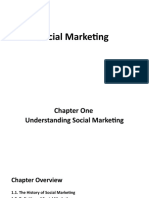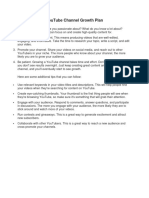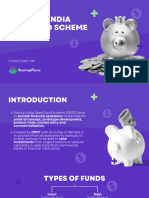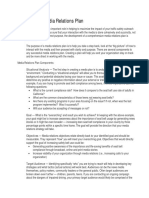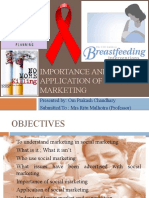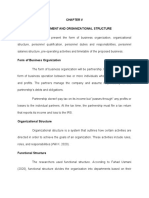0 ratings0% found this document useful (0 votes)
41 viewsSocial Marketing Seminar Vio - 50
Social Marketing Seminar Vio - 50
Uploaded by
api-263317637Copyright:
© All Rights Reserved
Available Formats
Download as PPTX, PDF, TXT or read online from Scribd
Social Marketing Seminar Vio - 50
Social Marketing Seminar Vio - 50
Uploaded by
api-2633176370 ratings0% found this document useful (0 votes)
41 views50 pagesOriginal Title
social marketing seminar vio - 50 - ppt
Copyright
© © All Rights Reserved
Available Formats
PPTX, PDF, TXT or read online from Scribd
Share this document
Did you find this document useful?
Is this content inappropriate?
Copyright:
© All Rights Reserved
Available Formats
Download as PPTX, PDF, TXT or read online from Scribd
Download as pptx, pdf, or txt
0 ratings0% found this document useful (0 votes)
41 views50 pagesSocial Marketing Seminar Vio - 50
Social Marketing Seminar Vio - 50
Uploaded by
api-263317637Copyright:
© All Rights Reserved
Available Formats
Download as PPTX, PDF, TXT or read online from Scribd
Download as pptx, pdf, or txt
You are on page 1of 50
SOCIAL MARKETING
Fasten your seat belt.
Eat more fruit.
Pull over to talk on your cell phone.
Dont litter.
Get a mammogram
Content of the Seminar
1. Introduction
2. What is social marketing?
3. Historical Background
4. Framework for social marketing
5. Uses in public Health
6. Merits and Demerits
7. Conclusion
8. References
Social change
happens when
We change internal
attitudes,
external structures,
and/or work to make
behavior unnecessary.
about seat belt use by
convincing people through
education and persuasion
by using public policy to
mandate seat belt use
Creating cars and
highways that are so safe
you dont need to convince
Example of highway
traffic safety
People are more likely to adopt a new idea quickly
if it exhibits these characteristics:
It has a relative advantage over what exists
Its compatible with social norms
Its not too complex
It can be tried out
You can see someone either doing or using it
What is Social Marketing?
One well-known definition of social marketing is
"the application of commercial marketing technologies to
the analysis, planning, execution, and evaluation of
programs designed to influence voluntary behavior of
target audiences in order to improve their personal welfare
and that of society.
It is a process for influencing humane behavior on a large
scale, using marketing principles for the purpose of societal
benefit rather than commercial profit.
Key points in this definition:
Social marketing :
1. Uses commercial marketing strategies.
2. Involves influencing voluntary (not forced or coerced) behavior
change (not just increased awareness or increased knowledge).
3. Promotes an end goal of improved personal welfare and
improved welfare of society.
It covers a wide variety of disciplines including health education,
advertising, economics, business management, scientific
research, systems analysis, community organization psychology
and epidemiology.
Social marketing aims to persuade or motivate people to adopt
specific courses of action or behavior which are generally
accepted as being beneficial.
Objective :
The objective of social marketing is to promote public health,
and its goal is improved health for all. Its strategy is therefore
predominantly preventive. It could even be seen to be in
competition with commercial health care marketing as it seeks
to reduce the market for curative services.
History :
Social marketing, especially as applied to health, has had a
fairly controversial history.
The term "social marketing of health" was fallen upon by
accident during the 1960s as a useful distinction from
commercial marketing. It received acclaim in July 1971 when
the Journal.of mpr oduced an issue on the topic (Kotler, 1971).
Similarities to commercial marketing
include:
Customer-orientation is critical
Audiences are segmented
All 4Ps are considered
Market research is key to success
Results are measured for improvement
In commercial marketing, however:
Financial versus societal gain is the goal
Goods & services are sold versus behaviors
Competitors are other similar organizations
Social Marketing is a process that uses marketing principles
and techniques to influence target audience behaviors that
will benefit society as well as the individual. This strategically
oriented discipline relies on creating, communicating,
delivering, and exchanging offerings that have positive value
for individuals, clients, partners, and society at large.
By Nancy R. Lee, Michael L. Rothschild,
and Bill Smith, 2011
The design, implementation and control of programs
calculated to influence the acceptability of social ideas and
involving considerations of product planning, pricing,
communication, distribution and marketing research.
by Kotler and Zaltman
DEFINITIONS:
Differences :
Social Marketing IS Social Marketing IS NOT
A social or behavior change
strategy
Most effective when it
activates people
Targeted to those who have
a reason to care and who are
ready for change
Strategic and requires
efficient use of resources
Integrated and works on the
installment plan
Just advertising
A clever slogan or messaging
strategy
Reaching everyone through a
media blitz
An image campaign
Done in a vacuum
A quick process
LIMITATIONS :
Social marketing is NOT
Just advertising or communication.
A media campaign.( this is the most people think of when they
hear term marketing.)
Not driven by Organizational experts agenda (it is a balance
between the expertise of professionals and the experiential
expertise of our audience(s).)
Reaching everyone.
A fast process.
A theory.
When Should We Use Social Marketing?
1. when voluntary behavior change is our goal and
2. we desire an audience-focused program
3. Also, we must have the time and skills to adhere
to the process.
You would not use social marketing if you were only trying to
educate or raise awareness. Although, if the hope is that
education or awareness will lead to behavior change, then social
marketing would be appropriate
Confusion :
Social marketing in public health should not be confused
with the marketing activity of new commercial health
care and hospital corporations.
The aim of the latter is to market health products and
services for the profit of shareholders. The coincident
benefits to health are part of the business objective and,
it may be argued, need not always be "beneficial" to
health.
OhMore Confusion
What is Societal Marketing Concept?
The overall idea of societal marketing concept is to have those
who market to the public take into consideration what is
socially good for the public.
Most social marketing efforts are applied to:
Improving public health (e.g. HIV/AIDS, tobacco use, obesity,
teen pregnancy, tuberculosis)
Preventing injuries (e.g., traffic collisions, domestic violence,
senior falls, drowning)
Protecting the environment (e.g., water quality, air quality,
water conservation, habitat protection)
Contributing to communities (e.g., voting, spaying and
neutering pets, volunteering, crime prevention)
Applications :
Continuum of Interventions
Unaware/
Considering Change/
Maintaining Behaviour
This shows you where social marketing fits in with other
interventions to support behavior change.
Aware/
Not Considering
Change
Entrenched/
No desire to Change
Education
Social Marketing
Law
What is
your son
reaching for ?
Give him a Strong foundation
for his future by treating
his mother
with respect.
Because social marketing is based in a strong strategic
planning process, and because of its insistence that you
understand your audience, it really can give you a 360
degree view of both the causes of a problem and
potential solutions. Even if your organization cannot
address all of the causes, at least you can make an
informed decision on which solutions are within your
purview, and which will most move the needle on
behavior change.
PRINCIPLES & TECHNIQUES
OF SOCIAL MARKETING
Components of Social Marketing
Social Marketing Consists of ?
Audience orientation
Audience segmentation
Influencing behavior
Competition
Exchange.
Marketing mix
Components of Social Marketing
Audience
Orientation
Audience
Segmentation
Influencing
Behaviour
Competition
Exchange
Marketing Mix
Addressing these elements
collectively is what makes social
marketing different from other
public health planning approaches.
1. Audience Orientation
Social marketing planners take time to learn
What the target audience currently knows,
believes, and does.
All decisions are made with the audience's
perspective in mind.
The program is designed to fulfill the audience's needs
and wants.
Target Audience
The group that your social marketing program seeks to reach and
influence. This group is a
selected portion (or segment) of a larger population that is directly
affected by the health problem.
2. Audience Segmentation
The process of dividing a broad target audience into more homogeneous
subgroups, called audience segments.
We segment our audience because
a) different factors in peoples lives can contribute to the same
problem.
b) Different life circumstances can require different interventions.
A one-size solution does not fit all.
c) And also the purpose of dividing up an audience into segments is to
make our program more effective and to use our resources wisely
For example:
Completely different programs would be designed for these two
segments:
1. Overweight adults who do not enjoy physical activity and are not
motivated to participate in it. (The program for this segment would
need to address the target audience's motivation before behavior
change can be expected.
2. Overweight adults who like physical activity and are motivated to do
it, but can't find the time during the day to participate in it. (The
program for this segment would need to address the target
audience's perception of the barrier of lack of time.
3. Influencing Behavior
Influencing behavior (not just awareness or knowledge) is
the bottom line of any social marketing program.
We may want our target audience
a) to adopt a new behavior,
b) stop a current behavior,
c) or refrain from starting a new behavior.
To do this, need to understand
Current behaviors of audience.
Ideal behaviors.
Reasonable steps to move the
audience from the current
behavior towards the ideal
behavior.
What determines their behavior.
The initial behavior change you
ask for may not be to adopt the
ideal behavior. The audience may
need to start with smaller
changes that move them towards
the ideal behavior.
Example
Current behavior: Watches
app. 5 hrs of TV per day
Recommended behavior:
Watching 2 or fewer hrs of TV
per day
Possible behavior change:
Reduce TV viewing by one
hour-long TV show per day
(an intermediate behavior
change that will move the
audience towards the ideal
behavior).
Influencing Behavior
4. Competition
Social marketing, like commercial marketing, takes place in a
competitive environment.
Competition is defined as the "behaviors and related benefits
that the target audience is accustomed toor may preferto
the behavior the program is promoting.
In social marketing programs, competition should be
acknowledged, explored, and addressed by the strategies of the
program.
5. Exchange
For every choice we make, there is an exchange that occurs: we
give one thing up in return for something else.
In the commercial marketing world, this exchange can be tangible
(pay an extra quarter and get more fries), or it can be intangible
(buy a brand-name pair of shoes and get the image that goes with
the brand).
While the exchange can be tangible in social marketing (paying a
higher price for a healthier vending machine option),
The exchange is often intangible, such as giving up a TV show to
go for a walk to improve one's health.
The exchange should increase the perceived benefits of the target
behavior and minimize its costs.
Or it could increase the perceived costs of the competing behaviors
and minimize their benefits.
We can use the concept of exchange several ways in
marketing...
A Pepsi
A thirst quencher
Good taste
Fun
Youthful feeling
Girl / boy friend
Exchange
$1.00
You Get You Give Me
Here is another public health example.
It is important for us to understand what our audience sees as the
costs and benefits of the behaviors or services
An immunization
Better Health
Avoidance of greater discomfort
Ability to go to school, work, travel
Money
Time
Momentary Discomfort
Here is a public health example.
The perceived benefits of the behavior must outweigh the
perceived costs in order for them to try it.
A Condom
Protection against pregnancy
Protection against STDs
Peace of Mind
Sense of Control
Hope for the future
A date
Exchange
75
Embarrassment
Loss of Pleasure
You Get
You Give Me
What is the cost of Behavior
Notice that the costs
associated with the
behavior we are asking
people to do are not
always monetary.
People go through a
cost/benefit analysis at
some level when they
decide to act.
The perceived benefits of
the behavior must
outweigh the perceived
costs in order for them to
try it.
Understanding Cost and
Benefit of Audience
It is important for us to
understand what our
audience sees as the costs
and benefits of the
behaviors or services we
are promoting!
Notice that the benefits
important to them are not
always health benefits.
In social marketing, we
strive to frame our
services or behaviors in
terms of benefits that are
important to our
audience.
While behavioral change is the firstand ultimategoal, it is most
likely to be achieved step-by-step through smaller, incremental
goals.
But
A readily achieved result will give the audience positive
reinforcement and put the programmer in a position to make
more changes that will eventually lead to the ultimate health
goal
4 Ps of Social Marketing
Marketing
Mix
Product
Price Place
Promotion
6. Marketing Mix
The marketing mix, also known as the "4 P's," is made up of four
parts that, together, create the exchange offered to the target
audience
Product: What the audience gets or what you offer; can be
tangible items, intangible benefits, or the behavior itself
Price: What the audience gives up to get a tangible product; also
the costs or barriers to making the desired behavior change
Place: Where the audience is located or gathers, performs the
desired behavior, accesses. products/services, or is thinking or
hearing about the health issue
Promotion: Messages, materials, channels (path used to reach the
target audience), and activities to promote behavior change and
describe the product, price, and place features of the program
We Discussed
Audience orientation
Audience segmentation
Behavior change
Competition
Exchange & Marketing Mix
Weve discussed the following elements
Audience orientation.
Audience segmentation.
Behavior change.
Competition.
Exchange.
Marketing mix.
There are the pieces of social marketing that, when integrated, form a social
marketing program. Again, it's the collective use of these elements that make
a social marketing program
Social Marketing Planning Process
The social marketing planning process is a structured approach to
developing and implementing a program or intervention for
voluntary behavior change. The planning process used in this training
consists of six phases.
Six Phases
1. Problem description
2. Formative research
3. Strategy development
4. Intervention design
5. Evaluation
6. Implementation
Social Marketing Planning Process
Six
Phases
The first plan component is the problem or health issue. In the
problem description phase, complete the following activities
to identify the problem and learn more about it
Define the problem or health issue.
Find existing information about the problem.
Identify contributing factors
Plan Components for the Problem
Description
Plan Component Questions to Ask and Answer
I. Problem / health issue
What is the problem we need to
address?
II. Target Audience
Who is effected by the problem and
how can they be reached?
III. Behaviour
What do we want the audience to
do?
IV. Strategies for change
How can we get the target audience
to adopt the desired behavior(s)?
In the problem description phase, complete the following
activities to identify the target audience and learn more about
them:
Determine the criteria for selection.
Identify potential broad target audiences (who should change
behavior).
Identify potential secondary audiences (those who influence
the primary target audience).
Example
Some examples of broad target audiences
Mothers with young children.
Somewhat active adults.
Employees of daycare centers.
Health care providers.
Adults living in a particular neighborhood.
Women who want to lose weight
Identify Audience Influencers As you review the literature and talk
to subject matter experts about the health problem, also consider
potential secondary audiences, or influencers. These audiences are
the people who can support or hinder behavior change in your
target audience. Once you identify and refine your target audience,
you can begin exploring the secondary audiences in more detail.
Gather information to help decide which behavior to promote.
Identify which potential behaviors are appropriate to address for
each broad audience.
Identify potential benefits and barriers that the audience faces
for changing their behavior. Benefits and Barriers As you
continue to look at existing behaviors that can be changed (or
new behaviors that can be adopted), consider the potential
benefits the audience may receive and what barriers they may
face. Be sure to consider the audience's perspective. What
benefits and barriers do they perceive? Which benefits and
barriers are most important to them?
An intervention strategy explains how and why you expect
behavior change to happen. During the problem description
phase, you will study theories, behavioral models, and existing
programs to identify potential intervention strategies.
Complete the following activities to learn more about
strategies for change
Identify factors or concepts from behavioral theories and
models that may help explain behavior change in your
audience.
Identify information about other programs, both successful
and unsuccessful.
Why is Formative Research Important?
Formative research will enable you to
Better understand your target audience and their needs and
wants.
Get useful information from the right people.
Make decisions with an audience-focused mindset.
Refine your social marketing plan to ensure success of your
program. Formative Research Process
The formative research process can be broken into seven main
steps:
Step 1: Analyze Information Gaps
Step 2: Write Research Questions
Step 3: Choose Data Collection Method
Step 4: Develop Instrument(s)
Step 5: Recruit Participants
Step 6: Collect Data
Step 7: Analyze and Report Findings
Step 3: Choose Data Collection Method
Step 2: Write Research Questions
Step 1: Analyze Information Gaps Step
Step 7: Analyze and Report Findings
Step 6: Collect Data Step
Step 5: Recruit Participants Step
Step 4: Develop Instrument(s)
The formative research process
Limitations of Social Marketing
Social marketing is not the only method of health education and
promotion. It is only appropriate in certain circumstances and has
limitations (Brieger and Ramakrishna 1987, Manoff 1985). These include:
1 . Smle of intervention:
The majority of health education and promotion techniques are based on
families, neighbourhoods, villages or institutions, whereas social
marketing is aimed at individu& at the city, state, national and even
international level.
2. Focus on isolated behaviour or products:
Social marketing may lead people with limited resources to perceive a
need to choose between the idea which is marketed and other health-
promoting behaviour. Traditional health education favors a more
integrated approach.
3. Major structural barriers
Social marketing is unsuitable where major structural barriers exist
against change in individuals. These include poverty, lack of health
facilities, political pressure, discrimination. Social marketing is also
inappropriate where the effort and resources of the individual alone
are inadequate to achieve the desired behaviour. These insuperable
problems should be appreciated and careful examination should be
made to determine whether or how far a social marketing programme
would be appropriate.
4. Decision-making: There are ethical difficulties as to who should
make the decisions or on what social behaviours should be promoted,
To remain an educational tool rather than a coercive mechanism,
social marketing must involve the consumer in decision-making.
5. Funding: Obtaining sufficient funding is always difficult.
Social marketing is often labour- and time-intensive. A cost effective
strategy must be drawn up for each case.
6. Lack of support for social marketing programmes:
Actual social marketing programmes are sparse due to lack of
information, demands on personnel and financial stringencies.
Trained social marketers are rare and since the financial rewards are
less, commercial marketers are unlikely to be attracted to the area.
Social marketing's target population is outside the cash
environment and is therefore culturally, socially and
psychologically different from profitmaking efforts. Progress is
also slow and results more difficult to achieve. Marketed health
programmes are frequently of very low priority within official
channels and they therefore lack resources and opportunities.
7. Lack of opportunity for educational use of the mass media:
Transmission licences often only have a vague reference to public
interest, which is often unenforced. Educational programmes may
be treated the same as commercial ventures rather than be
allowed free-time allocation. Alternatively, the channel or times
given for transmission may be poor in quality or ineffective due to
inappropriate timing. In addition, the mass media are aimed at
those with economic means and are less feasible in developing
countries due to financial difficulties.
"Getting the product right" in the Kenya Ministry of Health
Education Department
8. Poor management and implementation of a social marketing
effort:
Some of the problems that can be encountered by social
marketers in decision-making areas are outlined by Bloom and
Novelli (1981). The implementation of social marketing creates
greater problems than those experienced in the commercial
sphere.
Benefits :
Social marketing emphasizes advance testing of all concepts,
messages and materials to obtain feedback.
Social marketing provides the health educator with a unique
opportunity to bridge the communication gaps between the
audience and the authorities; between educational assumption and
popular perception; educational content and marketplace reality;
between dissonant messages from other responsible agencies: the
health care system and those who are unmotivated to use the
system; and it tackles the competition between curative services and
prevention.
Guiding Theories :
Stages of Change Model describes six stages that people go through
in the behavior change process.
Social Norms Theory is based on the central concept that much of
peoples behavior is influenced by their perceptions of what is
normal or typical.
Health Belief Model emphasizes target audiences are influenced by
perceived personal susceptibility and seriousness of the health issue,
and benefits, barriers and cues to action for the desired behavior.
Theory of Reasoned Action /Theory of Planned Behavior suggests the
best predictor of behavior is intention to act and this intention is
influenced by perceived benefits, costs and social norms.
Social Cognitive Theory states that likelihood of adopting the
behavior is determined by perceptions that benefits outweigh the
costs and belief in self-efficacy (ability to perform the behavior).
Exchange Theory postulates that in order for an exchange to take
place, target markets must perceive benefits equal to or greater than
perceived costs.
You might also like
- A Competitive Analysis of Apple and NokiaDocument21 pagesA Competitive Analysis of Apple and NokiaDeejay Stix84% (74)
- Bakery Industry Analysis With Porter'S Five Forces Model: Prepared by Group BDocument19 pagesBakery Industry Analysis With Porter'S Five Forces Model: Prepared by Group BThant Thandar100% (1)
- Competitive Strategies in Retailing An Investigation of The Applicability of Porter's Framework For Food RetailersDocument13 pagesCompetitive Strategies in Retailing An Investigation of The Applicability of Porter's Framework For Food Retailersjoannakam0% (1)
- Overview of Persuasive Advertising-R8-N8.2.2014Document52 pagesOverview of Persuasive Advertising-R8-N8.2.2014Tawfik EwedaNo ratings yet
- BRANDINGDocument18 pagesBRANDINGAbdulahi Kunle AbdulfataiNo ratings yet
- Ambient Advertising - ReportDocument19 pagesAmbient Advertising - Reportmayankghatawat100% (1)
- Arena Animation Camp: - Creative Skill AssessmentDocument18 pagesArena Animation Camp: - Creative Skill Assessmentapi-27466465No ratings yet
- Assignment 3 - Rhetorical Analysis of Advertising and EnvironmentDocument2 pagesAssignment 3 - Rhetorical Analysis of Advertising and EnvironmentLondie T. MartinNo ratings yet
- Presentation On ClarksDocument28 pagesPresentation On ClarksKamil Hasnain100% (2)
- Chapter 1 PowerPointDocument34 pagesChapter 1 PowerPointSalma WaelNo ratings yet
- Social MarketingDocument61 pagesSocial MarketingSualih OumerNo ratings yet
- Bowman's Strategy Clock (Strategic Positioning)Document2 pagesBowman's Strategy Clock (Strategic Positioning)shanu104No ratings yet
- Social Media SlidesDocument46 pagesSocial Media SlidesBrijlal MallikNo ratings yet
- The Creative Director Career PlanDocument1 pageThe Creative Director Career Planongk0043No ratings yet
- Branding Corporate IdentityDocument33 pagesBranding Corporate Identityzintle.mgqongose3No ratings yet
- Advertising ManagementDocument146 pagesAdvertising ManagementArnav Bharadwaj100% (1)
- Elements, PrinciplesDocument14 pagesElements, Principlesyuvrajv219No ratings yet
- Chapter 7 Designing and Managing IMCDocument76 pagesChapter 7 Designing and Managing IMCNegosyo Center LaoagNo ratings yet
- Case Study Method and NegotiationDocument49 pagesCase Study Method and NegotiationAshwathi N KNo ratings yet
- Advertising & IMC: Principles & Practice: Strategic Brand Communications MKM803Document29 pagesAdvertising & IMC: Principles & Practice: Strategic Brand Communications MKM803jasmeetNo ratings yet
- Brand PromotionDocument89 pagesBrand PromotionHarsh SavlaNo ratings yet
- Graphic Design BraemarDocument19 pagesGraphic Design BraemarRyan McLay100% (1)
- Marketing MixDocument10 pagesMarketing MixVijay KumarNo ratings yet
- PR Roll During Crisis. Four Step PRPDocument9 pagesPR Roll During Crisis. Four Step PRPidoc716No ratings yet
- What Makes A Good Logo Design?: Graphics 2Document33 pagesWhat Makes A Good Logo Design?: Graphics 2ankitjuneja88No ratings yet
- Business Finance ManagementDocument14 pagesBusiness Finance ManagementMuhammad Sajid Saeed0% (1)
- Color Psychology OutlineDocument4 pagesColor Psychology Outlineapi-241500885No ratings yet
- A Framework For Strategic AnalysisDocument12 pagesA Framework For Strategic AnalysisbeautylandNo ratings yet
- YouTube Channel Growth PlanDocument1 pageYouTube Channel Growth PlanmalikNo ratings yet
- The Creative Side and Message Strategy: Part 4: Effective Advertising MessagesDocument18 pagesThe Creative Side and Message Strategy: Part 4: Effective Advertising MessagesmpnaharNo ratings yet
- 10 Step Marketing Plan TemplateDocument17 pages10 Step Marketing Plan TemplateNancy NagyNo ratings yet
- Chap 08 Creative Strategy Planning and Development 1225869015185737 9Document24 pagesChap 08 Creative Strategy Planning and Development 1225869015185737 9Ayu SrihadiNo ratings yet
- Week 3 GO TO MARKET STRATEGIES Communications Strategy & Fundamentals of PricingDocument65 pagesWeek 3 GO TO MARKET STRATEGIES Communications Strategy & Fundamentals of Pricingsakshi patelNo ratings yet
- Asian Paints Creative BriefDocument8 pagesAsian Paints Creative BriefAnuja KediaNo ratings yet
- The Impact of Digitalization On Logo DesignDocument49 pagesThe Impact of Digitalization On Logo DesignAleksandar MihajlovićNo ratings yet
- 2 LECTURE Creative Strategy Planning and DevelopmentDocument45 pages2 LECTURE Creative Strategy Planning and DevelopmentcutechanchalNo ratings yet
- Sisfs (Startup India Seed Funding Scheme)Document8 pagesSisfs (Startup India Seed Funding Scheme)Miscsap MiscNo ratings yet
- Module 1 - Digital Marketing FundamentalsDocument45 pagesModule 1 - Digital Marketing FundamentalsCitra RenjaNo ratings yet
- Spotify 1Document15 pagesSpotify 1Baadshah VermaNo ratings yet
- Wealth Creation: M&A (Mergers & Acquisitions)Document4 pagesWealth Creation: M&A (Mergers & Acquisitions)AishNo ratings yet
- 0 0 - MKT4930 - Advanced Theory and Issues in Outdoor AdvertisingDocument10 pages0 0 - MKT4930 - Advanced Theory and Issues in Outdoor AdvertisingDiamond MC TaiNo ratings yet
- Anatomy of An SMPDocument35 pagesAnatomy of An SMPScott KramerNo ratings yet
- Effective Public Speaking - Lvl1Document39 pagesEffective Public Speaking - Lvl1Marilyn Claudine N. BambillaNo ratings yet
- Communication ModelsDocument4 pagesCommunication ModelsCamille AdarnaNo ratings yet
- Developing A Media Relations Plan PDFDocument2 pagesDeveloping A Media Relations Plan PDFFlor HartridgeNo ratings yet
- Ad Campaign and Maketing PlanningDocument33 pagesAd Campaign and Maketing PlanningKeerat SinghNo ratings yet
- Guide To Developing The Elements of A Marketing PlanDocument11 pagesGuide To Developing The Elements of A Marketing PlanArlene TingsonNo ratings yet
- Cheat Sheet MarketingDocument3 pagesCheat Sheet MarketingCharlotte GillandersNo ratings yet
- LOGOS PresentationDocument51 pagesLOGOS PresentationRoopesh BabuNo ratings yet
- Individual Branding Vs Corporate BrandingDocument3 pagesIndividual Branding Vs Corporate BrandingMuhammad Zain Imtiyaz100% (1)
- Design Great LogoDocument21 pagesDesign Great LogoPranab SinghNo ratings yet
- Video Marketing Strategy: The Ultimate GuideDocument6 pagesVideo Marketing Strategy: The Ultimate GuideandrewNo ratings yet
- Rob Stokes-eMarketing The Essential Guide To Online Marketing-Quirk Emarketing (2008)Document189 pagesRob Stokes-eMarketing The Essential Guide To Online Marketing-Quirk Emarketing (2008)iarinadem2011100% (1)
- Social MKTG PPT 1Document25 pagesSocial MKTG PPT 1abdelamuzemil8No ratings yet
- Social Marketing - 20240507 - 102513 - 0000Document16 pagesSocial Marketing - 20240507 - 102513 - 0000Anjali SinghNo ratings yet
- Pulu Social MarketingDocument16 pagesPulu Social MarketingAshish NikamNo ratings yet
- Societal MarketingDocument7 pagesSocietal MarketingthangarajNo ratings yet
- Nutrition Mass Media CampaignDocument3 pagesNutrition Mass Media CampaignWania Shahid100% (1)
- Social Marketing All ChaptersDocument65 pagesSocial Marketing All Chaptersabdelamuzemil8No ratings yet
- Social Marketing in Health: Presenter-Dr. ManjuDocument76 pagesSocial Marketing in Health: Presenter-Dr. Manjuabdurehman khanNo ratings yet
- Importance and Application of Social MarketingDocument27 pagesImportance and Application of Social MarketingSaptarshi BagchiNo ratings yet
- Social Marketing All ChaptersDocument65 pagesSocial Marketing All Chaptersmekuanentfekadu5No ratings yet
- Social Marketing B04 BRMDocument10 pagesSocial Marketing B04 BRMMihir SawantNo ratings yet
- Social Marketing NotesDocument63 pagesSocial Marketing NotesRishabh HemaniNo ratings yet
- Soccer Academy Business Plan TemplateDocument7 pagesSoccer Academy Business Plan Templateqjr93qwjNo ratings yet
- ElSewedy CablesDocument33 pagesElSewedy CablesMai Hosny Ashmawy67% (3)
- Fundamental of Business 1st Assignment 2018Document21 pagesFundamental of Business 1st Assignment 2018Irfan MeharNo ratings yet
- Apm MGTDocument30 pagesApm MGTMalathi Meenakshi SundaramNo ratings yet
- BCG 100 Global Challenges 2009Document38 pagesBCG 100 Global Challenges 2009kinshuksNo ratings yet
- Advertising Unit - 1Document60 pagesAdvertising Unit - 1Gowrilingeswari MaharajaNo ratings yet
- Halfords SampleDocument15 pagesHalfords SampleJose JosephNo ratings yet
- Beichen Lin (Case Studies-Developing Sound Strategies)Document7 pagesBeichen Lin (Case Studies-Developing Sound Strategies)asdf lmaoNo ratings yet
- Tabulation SheetDocument5 pagesTabulation SheetNetski's Sweets100% (1)
- Strategic ManagementDocument18 pagesStrategic ManagementMichael Yule100% (1)
- Strategic Management Handout 1Document14 pagesStrategic Management Handout 1Ahsan AliNo ratings yet
- PSDA 3 Competitive IntelligenceDocument11 pagesPSDA 3 Competitive Intelligencemittal anuragNo ratings yet
- 5th StrategicDocument13 pages5th StrategicJorame BermoyNo ratings yet
- Siblings 2Document2 pagesSiblings 2MNo ratings yet
- Chapter 5 and 7Document10 pagesChapter 5 and 7Rafael BacalandoNo ratings yet
- The Solider Athlete ConnectionDocument13 pagesThe Solider Athlete ConnectionJohn Rohrer50% (2)
- CogniZant CaseDocument5 pagesCogniZant CaseBhuwanPandeNo ratings yet
- Business Environment 4Document105 pagesBusiness Environment 4Jasmandeep brarNo ratings yet
- NintendoDocument5 pagesNintendoafif12No ratings yet
- Oflanagan Nonprofit ConsultingDocument20 pagesOflanagan Nonprofit ConsultingknaveenchandNo ratings yet
- Case Ans MKT 201Document9 pagesCase Ans MKT 201Shihab Uddin AhmedNo ratings yet
- Modeling Applications in The Airline Industry Ch1Document17 pagesModeling Applications in The Airline Industry Ch1Abhinav GiriNo ratings yet
- Competitive Profile MatrixDocument5 pagesCompetitive Profile MatrixAbdurrehman Muhammad SalimNo ratings yet
- SWOT Analysis: (Strengths, Weaknesses, Opportunities & Threats)Document19 pagesSWOT Analysis: (Strengths, Weaknesses, Opportunities & Threats)Yogesh SharmaNo ratings yet
- Tiếng Anh Kinh DoanhDocument168 pagesTiếng Anh Kinh DoanhAnh Bùi QuỳnhNo ratings yet
- Kalibrate 7E White PaperDocument16 pagesKalibrate 7E White PaperHussein BoffuNo ratings yet










